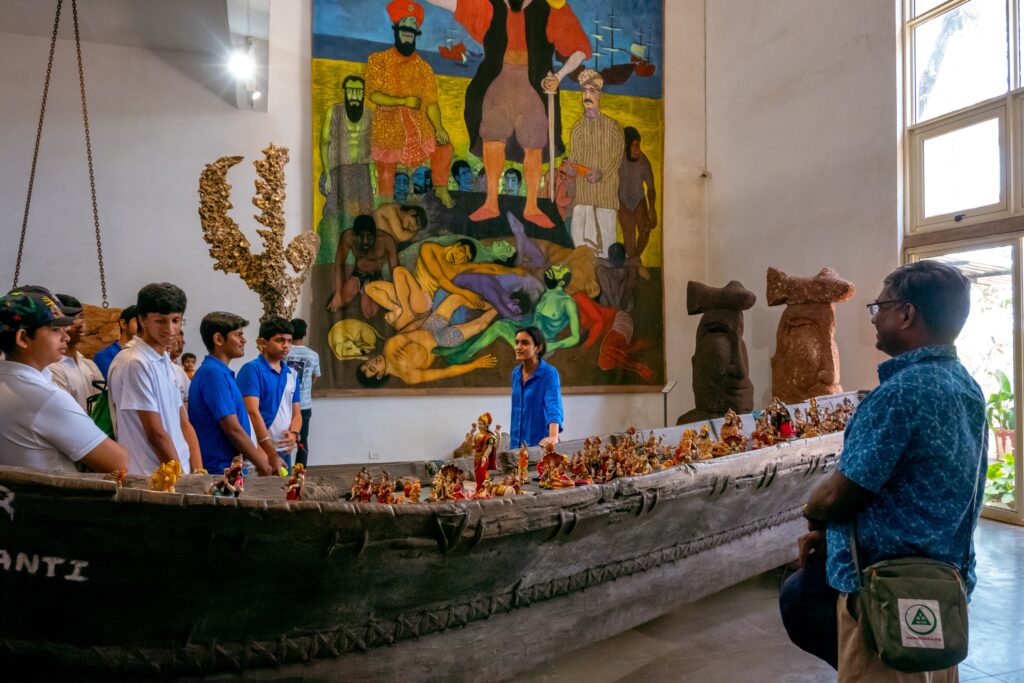
Subodh Kerkar was born just two years before the liberation of Goa from Portuguese rule. His childhood years were basically walks on the beaches with his father, the artist Chandrakant Kerkar. Of course, these walks brought him closer to both his father and to the Ocean. Today, Subodh is the Founding Director of the Museum of Goa and has exhibited in India and abroad.
Terracotta Sculptures and Portuguese Influence
You will see many rooftops in Goa with terracotta sculptures of roosters. It could be the impression of the Portuguese symbol of “Galo de Barcelos.” Students have made these sculptures after being influenced by a Folk song of Goa, which has the lines of a mother addressing her lovely rooster.
Unique Works and Themes
Subodh Kerkar frequently works on natural material-based themes. One of his works is an egg and vice that signify a child represented by an egg and a vice symbolizing social conditioning. Much of the work that Kerkar made is interwoven with the history of Goa. Installations like “The Old Man and the Fish” show his specific relationship with the ocean, habitually following materials attested to be in Goa: mussel shells, pebbles, and palm leaves. This work acts as an ode to Goa because it loves fish and a nod toward Ernest Hemingway’s novel “The Old Man and the Sea.”
Researching Juxtaposition and Local Material
In “The Old Man and the Fish,” Kerkar has used laterite stone and iron nuts. Laterite stone is found in abundance in Goa and is commonly used in construction material that carries a rusty red color due to iron oxides. Another major work is “Triumphant Trio” by Viraj Naik, a large work reflecting on historical incidents like Vasco-da-Gama’s voyage and the story of Thimmaya, who escaped execution and became a local agent.
Ocean-Inspired Installations
Kerkar’s installation “Mussel Shells Ocean” composed thousands of mussel shells in dynamic patterns that alter with the movement of a viewer thus celebrating the influence of the ocean on the culture of Goa. He relates how an old anchor was discovered by him, covered with mud, in the Tiracol River, which he cleaned thoroughly and turned into a beautiful sculpture.
Cultural and Historical Reflections
Much of Kerkar’s work is therefore informed by some amount of the cultural history of Goa. One piece uses fragments of a wall belonging to a 150-year-old house, with its many layers of paint showing its historical transformation. Chillies also find a place in his sculptures, made from fibreglass – an integral part of Indian cuisine today, but who had been introduced by the Portuguese, rubber tyres, and cotton fabric.
Technology and Collaboration
The ocean is integral to Kerkar’s work, independent of being a subject or a collaborator. He has been working on large seashore installations charged with history and politics, often using technology as an inspiration.
Museum Vision
The vision for the Museum of Goa is not a repository of artifacts or objects but a continuous evolving art. In a laboratory of ideas, one where different art forms are constantly in dialogue. Souvenirs given are in the shape of Goan windows. It interestingly showcases what this museum is—traditional yet innovative.
Historical Events Depicted
One installation, “The Slave Fork,” details the slave trade in Old Goa. Traders in Goa sold African slaves in the markets, often exchanging them for cowry shells or other goods.
Experiments with Nature
Kerkar collaborates with the ocean by dropping ceramic plates and fiberglass honeycombs down to the ocean floor. Over some period of time, the ocean covers those objects with oysters, which completely transfers them into art pieces. Kerkar merged art with natural processes that made the ocean itself become a co-creator of his work.


